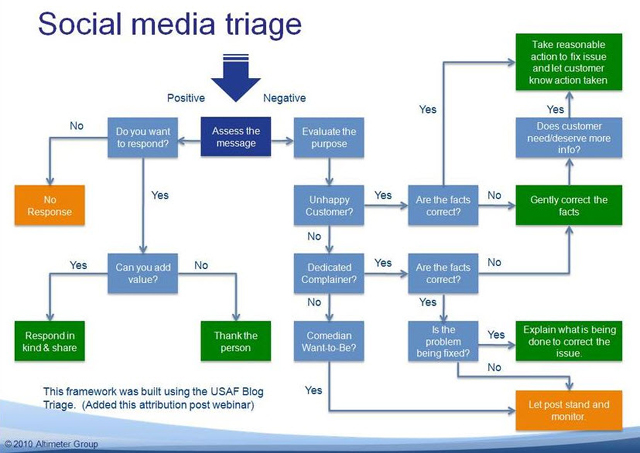Social Media Workflow: Crisis Management Response Charts
 As you develop your social media policy and strategy, a critical but often-overlooked component is an organized workflow that communicates rules for engagement for the entire team.
As you develop your social media policy and strategy, a critical but often-overlooked component is an organized workflow that communicates rules for engagement for the entire team.
Not having a workflow for engaging in social media conversations can decrease productivity and put your team at risk. Lack of coordination could mean that multiple team members are tripping over each other with similar responses or they are dropping the ball entirely and not being responsive with your customers.
The result is lost opportunities and potential customer dissatisfaction.
To help you make the most of your team’s social activity, I’ll explain in this post how to develop a workflow for a multi-functional team. I’ll focus on improving the speed and quality of response on social channels without overburdening your team with social media “responsibilities” that don’t yield results.
Let’s begin with a definition. A social media workflow is a one-page flowchart meant to help front-line staff decide:
- what is ok for them to respond to themselves
- when they need to consider escalation and involvement from senior staff
- when it might be better to let another community member address the situation.
It’s a series of connected steps designed to increase your team’s efficiency and minimize overlapping steps. Here’s an example:
 (image credit: altimeter group)
(image credit: altimeter group)
The first step in creating a flowchart is to establish your crisis management protocols. Once protocols are established you can create response charts to help your front-line responders prioritize conversations and escalate when necessary. Essentially your response chart is a visual representation of your protocol.
Level 1 – Evaluation
The first step in your crisis response chart is to evaluate conversations about your brand. Part of the evaluation stage is to determine whether a mention is positive or negative. Since this post focuses on crisis response we’ll spend our time on the negative side of the response chart. After all, we assume that by its nature a crisis is negative since we don’t know many people who jump up and do cartwheels when a crisis hits. However, we do see frantic seizure-like bodies waving their arms in the air while miraculously holding a cell phone to their ear. We’ll try to help prevent that in your company.
Level 2 – Prioritize
At the next level the front-line responder needs a mechanism for assessing the level of threat a negative post could have on the organization. It is important to be able to quickly distinguish between basic customer service complaints and an all out crisis. It’s common to see an assessment that includes questions for different areas of the business. The metrics below are simply guidelines. You should select ones that make sense for your business.
Questions for Customer Service
- “Is this a general customer service complaint?”
- “Does this affect more than 10 customers, 100 customers, 1,000 customers?”
- “Has volume of mentions on the specific topic increased >15%?”
- “How would you rate the potential impact on revenue? (1-5)”
Questions for Public Relations
- “Has an influencer, major blogger, or national media outlet mentioned it?”
- “Have more than 4 bloggers or media outlets mentioned it?”
- “Have mentions on the topic at hand increased >15%?”
- “Is the issue about the company?”
- “Is the issue about an employee at the company?”
- “Rate the potential impact on brand sentiment (1-5)”
- “Rate the potential impact on brand reputation (1-5)”
Questions for Management
- “Rate the potential impact on short term revenue. (1-5)”
- “Rate the potential impact on long term revenue. (1-5)”
- “Rate the potential impact on employee satisfaction. (1-5)”
- “Rate the potential impact on brand reputation. (1-5)”
Level 3 – Respond
Since your response chart is a visualization tool it is common to see these types of questions laid out in a yes / no format with recommendations for responding and escalating accordingly. When rating charts are used you can use the score followed by the action required. Items that receive a 2 or below can usually be managed at the front-line with a courtesy FYI for management. Items that receive a 3-4 should be escalated to management and a response will likely be a coordinated effort. Items that receive a 5 should be escalated to the highest levels of management and a response will likely be coordinated between the multiple departments that are impacted. Some companies also use a cumulative score to assess the level of crisis at hand and have appropriate response protocols documented based on the overall score.
Don’t Forget to Map Existing Processes. There’s no need to reinvent the wheel. Start with your existing workflows for routing customer inquiries and concerns. Then build out best practices that align with your current processes. The most successful crisis management plans incorporate existing response mechanisms and frameworks and then layer on nuances for conversations in the social channel.

Test the limits and break it. Take the process to the limit by simulating crises internally. If you’ve missed a step or left out a crucial department or stakeholder, you’ll know it. Defining the rules of engagement means taking a variety of scenarios into account and planning multiple outcomes. A flowchart is a starting point, not a destination. The culture of your organization, leadership, and individual discernment are still very important.
Remember: a social media response flowchart is not your social media crisis plan. It’s intended to be a tool to help your front-line staff evaluate situations as they happen.
Using a flow chart, they can decide which situations they can handle themselves and which might require the involvement of – and response from – someone else internally. As you create your own plan and response flowchart: understand the role of social media in crisis management.
A crisis management protocol and response chart can be an amazing tool for front-line responders, but it has its limitations. Put simply, it can’t fix questionable business policies that get called out by customers or anyone else with a voice in the social channel.
Real World Examples
Progressive Insurance came under fire when Matt Fisher accused them of defending his sister’s killer in court to avoid paying their family. As a result the online outcry over Matt Fisher’s claims led to a tremendous spike in negative mentions about the company that largely went unhandled. This is a situation of a brand that came under fire and struggled to respond in a timely fashion that could have possibly prevented some of the backlash. Be prepared, that when something like this happens, no response can easily be interpreted as guilt.
On the other hand, there are shining examples of companies who got out in front of a situation and possibly avoided a much larger issue. Domino’s used honesty and a heart-felt apology when they came under attack.
The Red Cross used humor to quickly jump in-front of a possible crisis when a rogue tweet found its way into the limelight. The result was a fundraiser and blood drive campaign that was promoted by Dogfish Head and helped to further their cause.
Should small or medium sized businesses have a crises response chart?
While it may not be practical for smaller businesses to have detailed charts and conduct formal training, it is still critical to think through all of the questions and discuss with the team how you will respond to a crisis.
Sometimes managing a crisis is as simple as being human, showing honesty and being transparent about the mistake . Other times, it’s an exercise in all out damage control, just ask Kenneth Cole.
Tip: Rignite is a single platform for you to monitor your social networks for a potential crisis, and to coordinate the best response. Click here to sign up for a free trial.
Do you have a crisis response chart at your company? Have you run through simulations to test your processes? Leave a comment and join the conversation.
